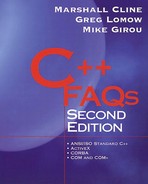Chapter 18. Access Control
FAQ 18.01 What is the purpose of this chapter?
This chapter presents the three types of access control in C++ classes. Access controls allow the programmer to declare a class's members as public:, protected:, and/or private:.
FAQ 18.02 How are private:, protected:, and public: different?
The situation is similar to personal secrets (shared only with friends), family secrets (shared with friends and children), and nonsecrets (shared with anybody), respectively.
A private: member of a class is accessible only by members and friends of the class.
A protected: member of a class is accessible by members and friends of the class and by members and friends of derived classes, provided they access the base member via a pointer or a reference to their own derived class.
A public: member of a class is accessible by everyone.
There is no difference between the access rules for data members and member functions. “Members and friends of class X” include member functions of class X, friend functions of class X, and member functions of friend classes of class X.
FAQ 18.03 Why can't subclasses access the private: parts of their base class?
The base class encapsulation has to protect itself from being undermined.
Suppose a subclass could access the private: portion of its base class. Would it make sense if just anyone could take away the option for the base class developer to change internal mechanisms in the future because they had subclassed a base class and locked in on its implementation? That would not be in anyone's best interests. So there is a need for ways to distinguish between
• Mechanisms and services that are available to everyone, the public: interface
• Mechanisms and services that are available only to subclasses, the protected: interface
• Mechanisms and services that are reserved for change without concern for breaking user code, the private: interface
Note that this is not a security issue. Developers can always look at the header files to see what is going on. The key notion is that the designer makes different promises to different audiences, and access controls provide a way to do that.
Also, notice that a subclass can access the protected: portion of its base class only when it acts specifically as a subclass. It cannot access the protected: portion of an object of its base class that is freestanding or of a different derived class.
FAQ 18.04 What's the difference between the keywords struct and class?
The difference is mostly perception.
From a pure language perspective, the major difference between the keywords struct and class is the default access level assigned to members and base classes. The default access level assigned to members and base classes of a struct is public:, while the default access level for members and base classes of a class is private:. Regardless, it is best to put an explicit public, private, or protected in the base class specifications, and it is usually best for the class to start with an explicit public:. With that approach, these defaults are of little consequence in practice.
The perception, however, is very different. A struct is perceived as an open bucket of bits. Most structs have very few member functions (often they have only a constructor), and they are often entirely public:.
FAQ 18.05 When should a data member be protected: rather than private:?
Some authors discourage protected: data in all cases on the grounds that it creates a stronger coupling with the derived class. For example, if a derived class were written by a customer or some other third party, changing the protected: data could break the derived class's code. In these situations, it is far better to create a protected: access function to the private: data rather than to allow direct access to protected: data by derived classes.
However, one size does not fit all. Although there are situations when third parties create derived classes, there are also many situations when they do not. From a practical standpoint, an organization often has a very well-defined notion of which classes will be inherited from by third parties, which classes will be inherited from internally, and which classes will not be inherited from at all. Those who erroneously believe that inheritance is for code reuse will be alarmed at that last statement, but when proper inheritance is practiced, inheritance is planned and prepared for ahead of time; it is not normally something programmers stumble into. (See FAQs 7.01, 8.12.)
FAQ 18.06 Why is private: the default access level for a class?
The default assumption makes small programs easier to read. For example, when a member function is defined within the class body proper (a practice that we are not advocating), it is easier to understand the code if the data appears before the code. Note that the compiler finds the class's data member independent of whether it appears before or after the usage, but human readers don't usually do a two-pass scan. Since the data is often private:, the default access level makes it a tiny bit easier when functions are defined within the class body proper. For example, this is particularly valuable for textbook examples that define member functions within their class to save presentation space.
But typical development efforts separate a lot of the implementation into a distinct file, such as a .cpp file. Thus, the problem with the member function coming before the data doesn't exist, and there is more reason to put the public: portion first. This lets the human reader see the interface portion of the class without having to wade through irrelevant implementation detail.
Different authors take different approaches to this issue, but we probably all subscribe to the same guiding principle. Any differences are due to our audiences and presentation style rather than philosophies.
